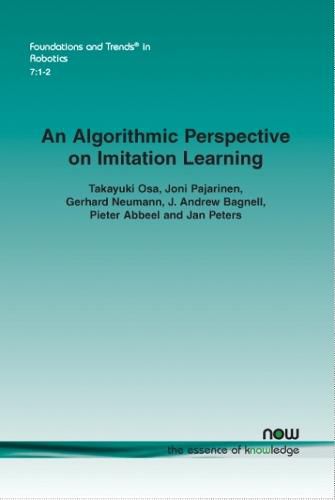Readings Newsletter
Become a Readings Member to make your shopping experience even easier.
Sign in or sign up for free!
You’re not far away from qualifying for FREE standard shipping within Australia
You’ve qualified for FREE standard shipping within Australia
The cart is loading…






This title is printed to order. This book may have been self-published. If so, we cannot guarantee the quality of the content. In the main most books will have gone through the editing process however some may not. We therefore suggest that you be aware of this before ordering this book. If in doubt check either the author or publisher’s details as we are unable to accept any returns unless they are faulty. Please contact us if you have any questions.
As robots and other intelligent agents move from simple environments and problems to more complex, unstructured settings, manually programming their behavior has become increasingly challenging and expensive. Often, it is easier for a teacher to demonstrate a desired behavior rather than attempt to manually engineer it. This process of learning from demonstrations, and the study of algorithms to do so, is called imitation learning. An Algorithmic Perspective on Imitation Learning provides the reader with an introduction to imitation learning. It covers the underlying assumptions, approaches, and how they relate; the rich set of algorithms developed to tackle the problem; and advice on effective tools and implementation. An Algorithmic Perspective on Imitation Learning serves two audiences. First, it familiarizes machine learning experts with the challenges of imitation learning, particularly those arising in robotics, and the interesting theoretical and practical distinctions between it and more familiar frameworks like statistical supervised learning theory and reinforcement learning. Second, it provides roboticists and experts in applied artificial intelligence with a broader appreciation for the frameworks and tools available for imitation learning. It pays particular attention to the intimate connection between imitation learning approaches and those of structured prediction.
$9.00 standard shipping within Australia
FREE standard shipping within Australia for orders over $100.00
Express & International shipping calculated at checkout
This title is printed to order. This book may have been self-published. If so, we cannot guarantee the quality of the content. In the main most books will have gone through the editing process however some may not. We therefore suggest that you be aware of this before ordering this book. If in doubt check either the author or publisher’s details as we are unable to accept any returns unless they are faulty. Please contact us if you have any questions.
As robots and other intelligent agents move from simple environments and problems to more complex, unstructured settings, manually programming their behavior has become increasingly challenging and expensive. Often, it is easier for a teacher to demonstrate a desired behavior rather than attempt to manually engineer it. This process of learning from demonstrations, and the study of algorithms to do so, is called imitation learning. An Algorithmic Perspective on Imitation Learning provides the reader with an introduction to imitation learning. It covers the underlying assumptions, approaches, and how they relate; the rich set of algorithms developed to tackle the problem; and advice on effective tools and implementation. An Algorithmic Perspective on Imitation Learning serves two audiences. First, it familiarizes machine learning experts with the challenges of imitation learning, particularly those arising in robotics, and the interesting theoretical and practical distinctions between it and more familiar frameworks like statistical supervised learning theory and reinforcement learning. Second, it provides roboticists and experts in applied artificial intelligence with a broader appreciation for the frameworks and tools available for imitation learning. It pays particular attention to the intimate connection between imitation learning approaches and those of structured prediction.